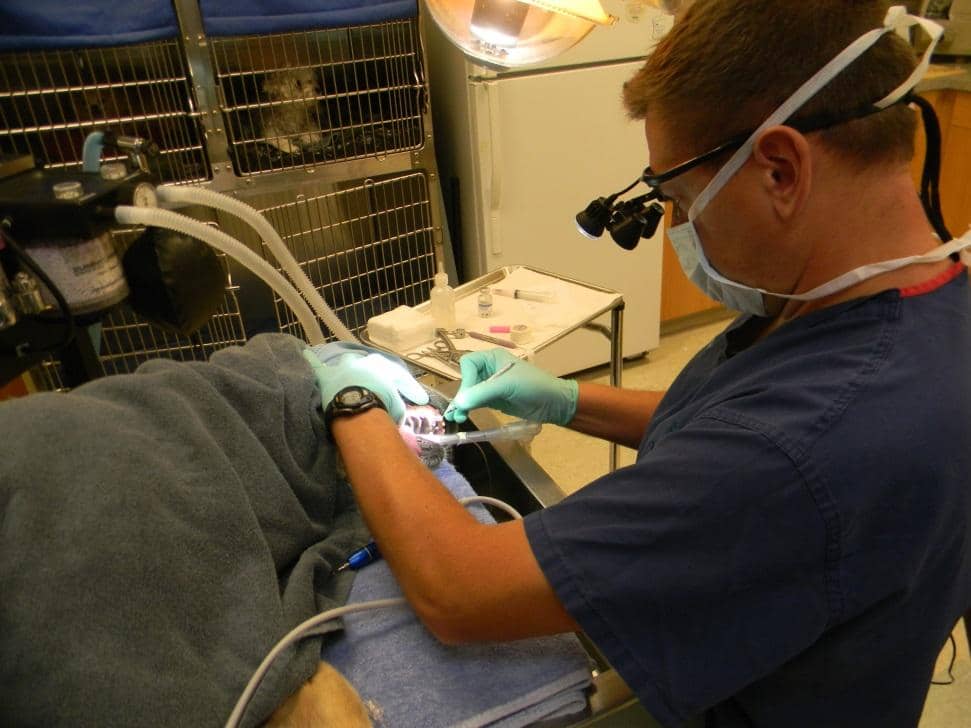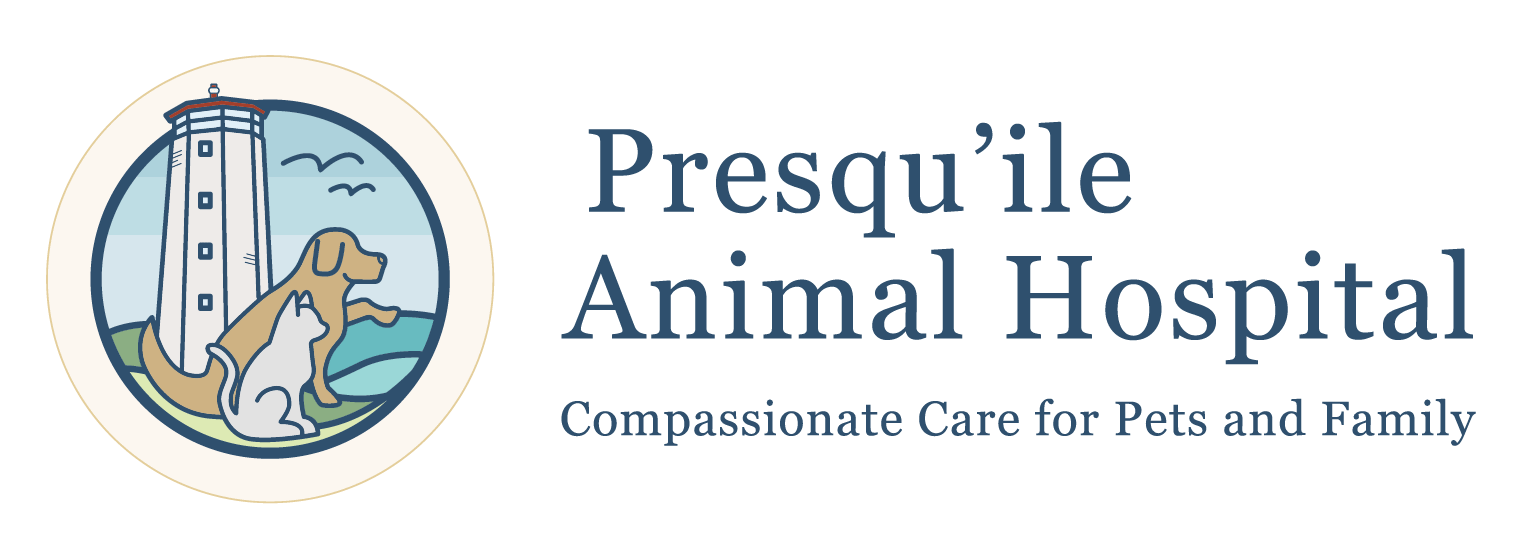Comprehensive Oral Health Assessment & Treatment
What to ExpectCOHAT Pre-Anesthetic Visit and Diagnostics
Prior to any surgical or dental procedure performed at our hospital we will schedule your pet for a pre-anesthetic visit.
During this visit your pet will have a complete physical exam to assess overall health and make sure there are no other health concerns that need to be managed.
The mouth and teeth will be examined as thoroughly as the pet will allow in order to provide an Estimate Range for what is anticipated to occur during the dental procedure. Note that we cannot determine the full extent of periodontal disease until under anesthetic when all surfaces of the teeth can be inspected, periodontal pocket depth measured, and dental radiographs taken.
Pre-Anesthetic Bloodwork is performed on all of our patients to help ensure fitness for undergoing anesthetic. We take every step possible to make the entire procedure as safe as possible. In some instances additional diagnostics such as an ECG, urinalysis or thoracic radiographs will be recommended.
Finally, oral medications will be sent home to be given the morning of the procedure. Anesthetic drugs can make us (and pets) feel nauseous, so we send home a medication called Cerenia which is an anti-emetic. We want to reduce the risk of nausea and vomiting during the procedure, and have them return to eating as soon as possible. We also send home Fear Free medication to help reduce anxiety about being dropped off at the hospital for the day. Gabapentin, one of the medications dispensed, also has analgesic properties, which allows us to provide pre-emptive pain management.
Your Pre-Anesthetic Appointment is usually booked the week before the COHAT is scheduled. Please come prepared with any questions you might have. We will go over what will happen during the procedure, and instructions for the night before and morning of your pet’s procedure, including what time to drop them off at our Hospital.
You will be sent home with a detailed Estimate/Treatment Plan, pre-anesthetic medications, and confirmation card with the date your procedure has been scheduled.
Our team will call the day before the procedure to review the drop off instructions.
Comprehensive Oral Health Assessment & Treatment
During a COHATFirst things First!
Why do we call it a “COHAT” & not a “dental”?
Many people used to refer to a veterinary oral exam and professional dental cleaning as simply “a dental”. However, we have shifted to calling the process a Complete Oral Health Assessment & Treatment, because that is a much better description of what actually occurs! The procedure is NOT just about cleaning teeth, but about a complete oral health and cancer screening, as well as treating and preventing oral disease for your pet.

Examination
During the COHAT, the veterinarian will first do a thorough examination of your pet’s mouth. In addition to checking all surfaces of the teeth, we assess for cancer and disease by assessing facial symmetry, palpating the mandibles and lymph nodes, assessing the lips, tongue, and tonsils, and measuring periodontal pocket depth in multiple areas around every tooth (an indicator of periodontal disease).
Since your pet is under anesthesia, this exam is far more complete and detailed than anything that can be accomplished in the normal exam room. Subtle changes, masses hidden under the tongue, and other crucial findings can be made on this exam which could be missed on a regular, awake exam.
Dental Radiographs
One of the most important parts of our examination is taking intra-oral dental radiographs under anesthetic. The amount of hidden periodontal disease (changes in the tooth roots and surrounding bone) that we discover by taking radiographs is astonishing! Cats and dogs will very rarely demonstrate any signs of oral pain. The fact that a patient is eating well should never be interpreted as a sign that the mouth is free of disease, as eating is necessary for survival and pets will continue to do so despite pain. Taking radiographs allows us to stage periodontal disease and the vitality of each individual tooth, allowing for treatment or extraction where required.

Treatments & Cleaning
After the examination the veterinarian can proceed to treatment of any disease found in your pet’s mouth. This may mean scaling and cleaning away tartar deposits (very common) on healthy teeth, followed with a polishing to smooth the enamel and make it more difficult for bacteria to adhere in the future. The equipment we use to clean your pet’s teeth is the same as what is used for people in a dental office. The ultrasonic tool for removing tartar has different tips and settings for cleaning above or below the gum line; this is one of the most critical parts of the COHAT, as so much of our pets’ dental disease is actually below the gum line. Without cleaning this crucial area, your pet’s plaque and tartar will come right back and the disease will continue deeper below the gum line to cause jaw bone disease
Sometimes teeth are so diseased that they may be loose and wiggly, or the bone around them may be infected or decaying. These teeth are sources of disease and pain, and thus, we often need to extract them to provide relief. Other teeth may have less severe disease and be repairable with restorations, open root planning, and guided tissue regeneration.
What About The Anesthesia?
We wish our pets would all “open wide” for our dental procedures, but even people have trouble with this request! Anesthesia is the only way we can safely do the deep cleaning required for your pet’s oral health. For routine cleanings your pet’s total anesthesia time is often around one hour, although if there are more advanced procedures or necessary extractions it will take longer. (Another reason to be proactive about dental care!) The dentistry patient receives intubation to ensure a clear airway for breathing, inhalant anesthesia, and supplementary oxygen; warming, and close monitoring including ECG, blood pressure, oxygenation, temperature, and a Registered Veterinary Technician to watch over them before, during, and after the procedure are also provided. While no anesthesia is without risk, every patient gets our best care during their dental procedure. Preanesthetic bloodwork, IV catheters, and fluids are always utilized. Our goal is always the best and safest treatment.
Still have any questions regarding COHATS?
Please contact us, we’re always happy to discuss further!
AFTER HOURS SUPPORT
Pet EmergenciesFor emergencies outside our clinic hours, please contact
Port Hope Veterinary Emergency Clinic & Services – 905.885.5321
The Kawartha Veterinary Emergency Hospital – 705.741.5832
Quinte Regional Pet Hospital – 613.968.9956

